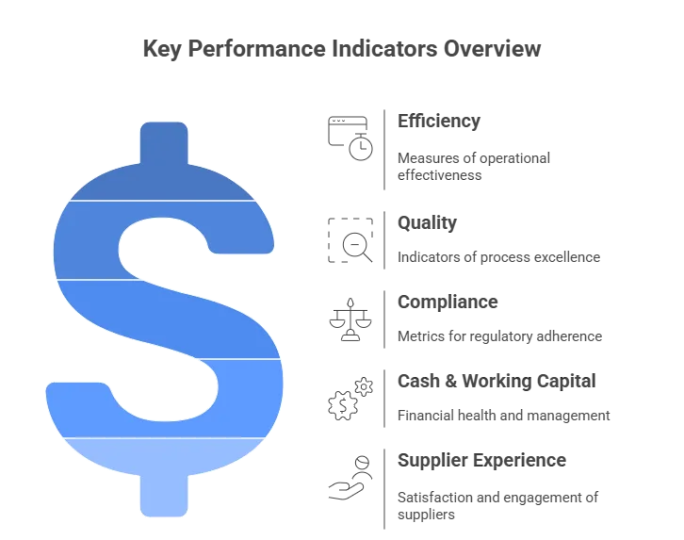Invoice Processing Automation (IPA) is the technology-led streamlining of invoice handling across the Procure-to-Pay (P2P) process, from data capture to validation, matching, approvals, and posting.
It converts a traditionally manual, error-prone workflow into a compliant, touchless operation where invoices are processed accurately, approved quickly, and auditable end-to-end.
IPA unifies diverse intake channels, e-invoicing, supplier networks, OCR, and EDI into one governed process. By linking purchase orders, receipts, and contracts, it ensures that every invoice reflects both procurement intent and financial accuracy.
Why Invoice Processing Automation Is Critical for Modern Procurement and Accounts Payable
Invoices are where purchasing commitments meet financial accountability.
Any delay, mismatch, or error can disrupt supplier relationships, skew working capital, or expose compliance risk.
Modern invoice automation solves these gaps by delivering:
- Speed: Faster invoice-to-post and invoice-to-pay cycles.
- Cost Efficiency: Lower cost per invoice and fewer manual touches.
- Accuracy: Tax, PO, and contractual compliance at scale.
- Visibility: Clear traceability from PO to payment.
- Compliance
- Control: Built-in fraud, duplicate, and audit safeguards.
Within Source-to-Pay, invoice automation becomes the operational handshake between procurement, finance, and suppliers, translating spend commitments into controlled payments.
Explore Zycus’ AI-powered Automated Invoice Matching Software
Core Stages of the Invoice Processing Automation Workflow
1. Ingestion and Data Capture
Invoices enter through multiple channels, supplier network, e-invoice exchange (PEPPOL, CTC), EDI feeds, or PDF/email.
Automation consolidates them into a uniform format, enabling immediate validation and matching.
- Structured intake: e-invoices, XML, or JSON parsed directly.
- Unstructured intake: OCR converts PDF and image-based invoices into data fields.
- Portal intake: Suppliers submit or flip POs directly, ensuring metadata accuracy.
Solutions such as Zycus eInvoicing combine these capture channels into a single workflow, ensuring near-zero data loss and faster invoice readiness.
2. Normalization and Enrichment
Once captured, invoice data is validated and enriched with enterprise master data, supplier IDs, PO references, contract links, tax codes, and payment terms.
System checks confirm field integrity, currency alignment, and duplicates.
Zycus’ validation engine ensures each invoice is normalized against vendor master and contract data before entering downstream processing, improving first-pass yield and match accuracy.
3. Matching and Validation
This is the intelligence core of automation, determining whether an invoice is payable.
| Match Type | Description | Used For |
| 2-Way | Invoice ↔ PO | Simple material/service orders without a receipt |
| 3-Way | Invoice ↔ PO ↔ Receipt (GRN) | Standard goods purchases |
| 4-Way | Invoice ↔ PO ↔ Receipt ↔ Service Entry/Quality Doc | Services or complex contracts |
Tolerance bands define acceptable variance limits (e.g., ±2% price, ±3 units quantity).
Invoices within these limits post automatically; those exceeding route for review.
4. PO vs Non-PO Invoices
Not all invoices are created equal.
PO-based invoices originate from an approved purchase order, providing a structured reference for quantity, price, and delivery terms. They flow through the automated matching process, 2-way, 3-way, or 4-way, ensuring compliance and budget alignment.
Download Whitepaper: What is a Non-PO Invoice in Accounts Payable?
Non-PO invoices, by contrast, arise from unplanned or indirect spend such as utilities, maintenance, travel, or subscriptions. These lack an originating PO and therefore require additional validation, policy checks, cost coding, and approval routing, before payment.
Zycus AP Automation applies configurable matching rules and adaptive tolerances to manage both PO and Non-PO invoices within a single intelligent workflow, enabling touchless processing, dynamic exception routing, and full audit control without manual rework.
5. Exception Handling and Workflow Orchestration
Invoices that fail validation or matching trigger exception workflows.
Typical triggers include price variances, missing receipts, duplicates, or tax inconsistencies.
Workflows route exceptions dynamically to buyers, receivers, or approvers based on spend category, variance type, and policy thresholds.
AI learns from recurring issues, if a specific supplier consistently triggers minor variances, the system recommends rule optimization rather than repeated manual review.
Zycus’ Smart Desk feature enables centralized visibility and SLA-driven resolution across exception queues.
6. Coding and Allocation
Each invoice line must be coded correctly before posting, by GL account, cost center, or project.
Automation auto-suggests coding based on:
- Linked PO or contract metadata
- Supplier and category pattern recognition
- Historical invoice data
Over time, AI improves coding accuracy and consistency across entities.
Within the Zycus platform, this intelligence is embedded in the matching and posting process, minimizing manual interventions in allocation.
7. Approvals and Policy Compliance
Approvals are governed by company policy, spend threshold, business unit, or category, and enforced through dynamic routing.
Approvers receive contextual information: invoice image, PO, contract terms, variance data, and supplier status.
Embedded controls prevent unauthorized bank changes, duplicate invoices, or tax misclassification.
Zycus workflow automation ensures approvals move efficiently while maintaining complete traceability for audit readiness.
8. Posting and Payment Readiness
Once approved, invoices are automatically posted to ERP (SAP MM/FI, Oracle AP, or Dynamics).
Payment scheduling aligns with DPO strategy, discount opportunities, and cash-flow goals.
Status updates sync with procurement and supplier systems — ensuring all parties see the same truth in real time.
Zycus’ integration with ERP and payment modules ensures invoices flow seamlessly from approval to posting, with full visibility into payment status.
Embedded Controls, Risk Management, and Compliance in IPA
Modern invoice automation embeds governance into every step:
- Duplicate Detection: Supplier + invoice number + amount + date, hashing to block re-entry.
- Bank Verification: Two-step approval for bank account updates.
- Contract Controls: Cap checks and clause compliance (e.g., not-to-exceed pricing).
- Audit Trail: Immutable logs recording every change, comment, and action.
- Tolerance Governance: Defined by policy, configurable by category or supplier type.
These controls ensure that every transaction meets audit, SOX, and internal control standards without slowing processing speed.
Tax, Regulatory, and E-Invoicing Compliance in Invoice Automation
Invoice Processing Automation ensures each invoice is processed under the correct tax and jurisdictional rules.
- Automated tax mapping: Applies VAT/GST rates by product, region, and exemption code.
- Reverse charge & withholding: Configured by country; auto-validated at posting.
- E-Invoicing mandates: Compliant with global clearance regimes — India IRP, Italy SDI, Mexico CFDI, Brazil NFe, and Saudi ZATCA.
- Retention: Archiving of tax invoices for legal duration with digital signature integrity.
Zycus’ e-invoicing engine supports multi-region compliance through direct integration with regulatory gateways and tax validation APIs.
AI, Machine Learning, and Predictive Intelligence in Invoice Processing
IPA today goes beyond rules-based automation, it learns and adapts:
- Predictive Analytics: Flags invoices likely to fail matching and recommends pre-checks.
- Adaptive Routing: Prioritizes approvals based on urgency and exception type.
- Anomaly Detection: Spots outliers in price, quantity, or supplier bank details.
- Continuous Learning: Refines coding accuracy and match tolerances over time.
The result, a self-optimizing AP process that gets more accurate with every invoice.
Key Performance Indicators (KPIs) for Automated Invoice Processing

| Category | KPIs |
| Efficiency | Cost per invoice, cycle time, touchless processing % |
| Quality | First-pass yield, exception rate, rework %, duplicate rate |
| Compliance | 3-way match %, tax error rate, audit finding count |
| Cash & Working Capital | Discount capture %, DPO adherence, penalty avoidance |
| Supplier Experience | Portal adoption %, dispute resolution time, query volume |
Tracking these KPIs ensures automation translates into measurable business value.
Key Terms in Automated Invoice Processing
- Invoice Processing Automation (IPA): End-to-end automation of invoice handling across the procure-to-pay (P2P) cycle, from capture to approval and posting.
- Accounts Payable (AP) Automation: The digital transformation of AP functions to improve accuracy, efficiency, and compliance in invoice and payment processing.
- Procure-to-Pay (P2P): The integrated procurement and finance process covering purchase requisition, purchase order, goods receipt, invoicing, and payment.
- E-Invoicing: Electronic generation, exchange, and validation of invoices in standardized formats like XML or PEPPOL for faster, compliant processing.
- 3-Way Matching: Automated validation of invoice details against purchase orders and goods receipts to ensure accuracy before payment.
- Touchless Invoice Processing: A fully automated workflow where invoices are processed, validated, and approved without human intervention.
FAQs
Q1. What is invoice processing automation?
End-to-end automation of AP tasks—capture → validate → match → approve → post—so low-risk invoices flow touchlessly while only true exceptions route to humans. The outcome: higher first-pass yield (FPY), shorter cycle time, and complete audit trails.
Q2. OCR vs AI invoice capture—what’s the difference?
OCR turns images into text but lacks context. AI/IDP learns supplier layouts, distinguishes headers vs. line items, normalizes units/tax, and validates against vendor master and PO/contract data—reducing manual fixes and boosting accuracy on messy PDFs.
Q3. What are the benefits of eInvoicing?
Structured data at source (XML/Peppol/clearance) cuts extraction errors, improves straight-through processing, lowers exception rates, strengthens tax compliance (VAT/GST schemas), and gives suppliers real-time status visibility.
Q4. How does touchless invoicing reduce costs?
By auto-applying 2/3/4-way matching within tolerance bands, predicting GL/cost center coding, and escalating only real exceptions. Fewer manual touches → lower cost per invoice, less rework/duplication, and faster discount capture.
References
Here are the resources related to Automated Invoice Processing:
-
- Smart contract management exploring use cases
- Building an effective contracting process is there a need
- 8 Signs Your Business Needs Automated AP Systems
- E-Invoicing in Accounts Payable: Boost Efficiency & ROI in Your Business
- The Ultimate Guide to Accounts Payable Automation
- Leveraging Accounts Payable Automation to Stay Ahead in a Competitive Market






















































